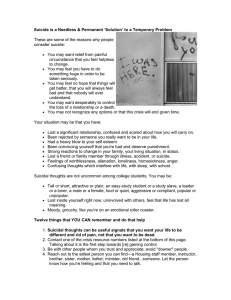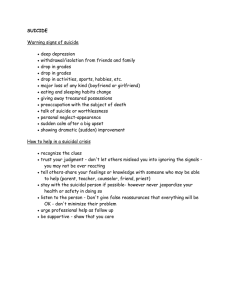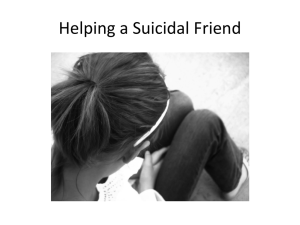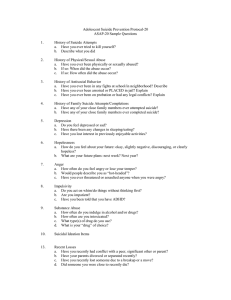Document 15759414
advertisement
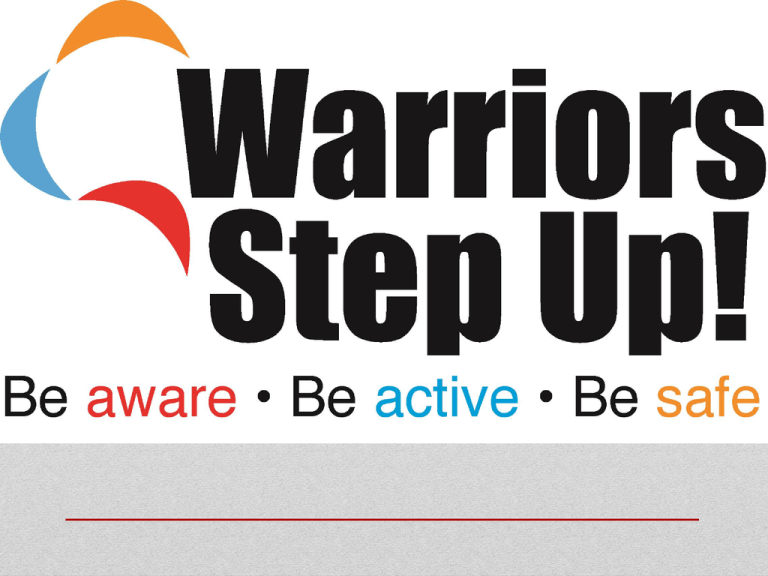
• Todays topic on mental health and substance abuse may create some feelings of uneasiness and or negative feelings for some people. Please feel free to take care of yourself if you notice any negative emotions surfacing as we discuss some of these difficult issues. Like always having an open, honest, and non-judgmental discussion about this material will lead to further learning for us all and will assist in our ability to make a significant difference in the life of those around us. • Raise awareness of helping behaviors • Increase motivation to help • Develop skills and confidence when responding to problems or concerns • Ensure the safety and well-being of yourself and others Goals of Step Up! The five decision making steps • • • • • Notice the Event Interpret it as a problem Assume Personal Responsibility Know How to Help Step-Up! Scenario 1 A friend calls you on the phone crying hysterically because her boyfriend just broke up with her. You know it was her first serious relationship and they did everything together. She keeps saying, “You just don’t understand, you don’t understand.” Clearly she is distraught. What do you do? Depression • Do you know someone who has thought about suicide or was severely depressed? What were the underlying issues? • Are there times you wish you could have talked to someone but didn’t because you thought it would be a sign of “weakness”? • How much of your identity/self worth is tied to being “a good student”, “athlete,” or “talented” in some other way? • Related to your self identity, what would you do if you could not perform to your own standards for some reason anymore? Depression • Students often do not seek help • culture of “not showing emotions,” “toughing it out,” or “fighting through the pain.” There is still some stigma over seeking help for mental health issues. • Depression is NOT a sign of personal weakness. People with depressive symptoms cannot merely “pull themselves together.” • Timely treatment can shorten the duration of symptoms and cut off the downward spiral. • Is critical to understand the link between mental and physical health and how one impacts the other. Depression . . . Sometimes follows: • Significant events – death, divorce, abuse, transitions/life changes, loss of romantic relationship/ friendship – Now what? Who am I? • Injury – short or long term • Other medical conditions • Identity as a person – disruption in view of self • Failure to live up to personal or external expectations Depression . . . Sometimes follows: • Significant change in status • Problems with instructors, parents, roommates • Substance abuse (individuals may choose to cope by using alcohol or other drugs) • Stress/Pressure – Academic, Athletic, Personal, Financial Scenario 2 You notice a student in your hall has been very down lately, more so than any circumstances you know of going on with her might dictate. Friends have also come to you about changes in her behavior. This person has become withdrawn and is not as active and social as before. You have become concerned. What do you do? Scenario 2 - Response? 1. Decide its really not my business and that she needs to work this out on her own. 2. Talk to her friends and ask one of them to intervene and then to report back to you what the student said. 3. Choose to bring this person to the attention of the Director of Residence Life so that she is aware of it and hopefully will deal with it. 4. Go directly to the student and ask if she is OK and discuss and support what she is experiencing. 5. Call the counseling office to let them take care of it. Depression • http://www.youtube.com/watch?feature=player_embedde d&v=HXCqvNAQaHM Suicide Sometimes follows: • • • • • • • A sudden lift in spirits following extreme depression Talking about suicide; previous attempts Physical or psychological abuse Fight with family member or loved one Embarrassment or humiliation Concerns about sexuality – social isolation/alienation Suicide of friend, acquaintance or celebrity (copycat suicide) Suicide Sometimes follows: • • • • • • • A sudden lift in spirits following extreme depression Talking about suicide; previous attempts Physical or psychological abuse Fight with family member or loved one Embarrassment or humiliation Concerns about sexuality – social isolation/alienation Suicide of friend, acquaintance or celebrity (copycat suicide) Scenario 3 You notice a resident from your hall has been wearing long sleeves lately. It seems a little odd to you because the weather outside is too warm for long sleeves. Also, you have heard he has been withdrawn and at times irritable. He seems to be under a lot of pressure but does not wish to talk about it. During an intramural basketball game you his sleeve slips just enough for you to see what appears to be a couple of old scars and a few new fresh cuts along his forearm – enough so that you are alarmed. What do you do? Other items. . . Also look for: • Frequency, duration and intensity/severity of symptoms. • The higher the number of signs the stronger the case to refer the person to a professional. • Emotional, cognitive, and behavioral changes: • feeling that nothing matters; lack of enthusiasm motivation, sad, withdrawn, tired, apathetic, pessimistic, anxious, irritable, distracted, forgetful, difficulty concentrating, remembering, or making decisions. Also look for: • Feelings of worthlessness or guilt; impulsive acts; reckless behavior; mood swings. • Neglect of personal welfare; deteriorating physical appearance. Significant weight gain or loss. • Changes in eating and sleeping habits. • No longer enjoying activities they once liked. Other items. . . Also look for: • Feeling misunderstood or rejected. • Frequent health complaints when no physical ailment exists. • Obsessive thoughts; All or nothing thinking. Other items. . . • Marked decrease in performance academically or athletically. • Self-mutilation. • Giving away possessions. • Lack of coping skills. • this problem hurting you or the other people? Other items. . . • Marked decrease in performance academically or athletically. • Self-mutilation. • Giving away possessions. • Lack of coping skills. • this problem hurting you or the other people? Other items. . . • www.youtube.com/watch?v=Ya_zfyFxHM0 Suicide . . . • LISTEN. • Take it seriously. Remember – depressive/suicidal behavior is a cry for help. • Speak with the individuals in private. Voice your concern — let them know you care. • Do what you can to give the person HOPE. Take Action. . . • Encourage the individuals to get help. It is NOT a sign of weakness to ask for help. In fact, it is a sign of STRENGTH. Offer to go with them to counseling. • Seek out a mature and compassionate person with whom you can review the situation. • Use the QPR Method – Question (about whether the individuals plan to harm themselves; Persuade (not to harm themselves) and Refer (to a professional). . Take Action. . . • If suicidal, create a “safety agreement” to not harm themselves. • If suicidal, call 9-1-1: let the individuals know that you will be contacting 9-1-1. Do not leave him or her alone. Engage other bystanders if need be. • If the individuals say they are going to take their own life, find out their intentions in terms of how they plan on doing it. This gives insights about risks to others, as well as more time and information to plan an intervention. Get as much information as possible. . Take Action. . . • Notice actions/behaviors. Be observant of any medication bottles that may be present; note other important information. • Separate the individuals from any weapons or firearms if possible. • Be aware of difficult times: holidays, birthdays, major anniversary dates. • What not to do: • Don’t assume the problem will take care of itself. • Don’t act shocked or surprised at what the person says. • Don’t argue or debate moral issues. • Don’t challenge or dare the person. . Take Action. . . • You may do your very best to help someone who is depressed or suicidal and your intervention may not be successful. It is a risk that you need to consider before becoming involved. Be sure to take care of yourself in these situations and get any help that you may need.. Reality Check . . . On campus • 9-1-1 or Campus Security especially for immediate crisis. • Student Counseling Services – 792-2211- RCH 111 YWCA Crisis line – 1-800-699-3176 • Debbie Kolstad and/or residence life staff • If an athlete, coaches or Tracy Collins, Athletic Trainer Referring resources . . . Off campus • 9-1-1 or Campus Security especially for immediate crisis. • St. Joseph Outpatient Mental Health – 799-6500 or St. Joseph Emergency Room • Lewiston Mental Health Center – 799-4440 • Idaho Suicide Prevention Lifeline – 1-800-273-TALK (8255) – idahosuicideprevention.org • ULifeline – Jed Foundation – LCSC - Self Evaluator Referring resources . . . • “It’s not hard to make decisions once you know what your values are.”- Roy E. Disney Decisions • Thank you for your work with students and for STEPPING UP!! Thank-you!

